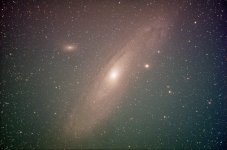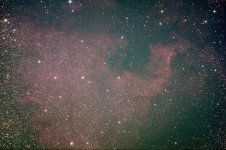Nycturne
Elite Member
- Posts
- 1,139
- Reaction score
- 1,489
I’ve done a bit of astrophotography in the past, but bounced a bit off the hobby as it can be a bit of climb before you start getting good data when going from widefield with camera lenses to telescopes with long focal lengths. I also live in light polluted skies which means even more effort to get good results from your data, or more trips to do imaging which can be taxing.
I’ve also been on the waiting list for a rather high end telescope mount for a couple years now. My name got to the top of the list and I decided to go for it. I’ve spent the last week or so just learning the mount, and setting up a mini PC so the whole thing can be used as a self-contained astrophotography rig. Last night, the clouds cooperated and I got some time to do some actual testing. I wasn’t expecting to do much here, just ensure I can run through some of the tools, achieve focus with the cooled camera I have had sitting around for years, and see how well it tracks.
The thing that impressed me the most is how well this setup tracks. The mount is a Mach2GTO, which includes absolute encoders. This allows it to almost immediately catch and correct nearly all tracking error stemming from the mechanics of the mount. You can also build a sky model that helps account for other sources of error like polar misalignment (to a point), atmospheric refraction at different altitudes, and the like. I don’t quite have things setup for guiding yet, so I decided to try building a sky model and going unguided. When the short frames looked good, I decided to see how far I could push things with this 500mm focal length scope. The result is two 10min unguided exposures. No calibration, stacking or other processing, so there is still considerable noise. They are just stretched to show the detail available.
Also impressive was the pointing. The capture software I’m re-learning on has a feature to slew and center a target. It slews to where it thinks the target is, takes a short exposure and plate solves the image to find out where you are actually pointing, and uses that to adjust the mount a bit more and center the target. Most mounts will not always slew to a target perfectly, because of things like atmospheric refraction, or error in star alignment procedures. This thing always put the target dead center every slew. Never needed a follow up adjustment after the plate solve. I’ve used mounts that were considered quite good for the price, but none of them are in the same class as this thing. I’m still picking my jaw off the floor.
There’s certainly things I need to address. It took over 100mm of extensions on the camera to come to focus, which probably added some vignetting you can see in the Andromeda shot. The field curvature is pretty extreme in this specific telescope, so I need to look at a field flattener. It looks like there is some drift from polar misalignment. No attempt at fighting the light pollution was done. Focus is a bit off. But still, this is not a bad start.
I’ve also been on the waiting list for a rather high end telescope mount for a couple years now. My name got to the top of the list and I decided to go for it. I’ve spent the last week or so just learning the mount, and setting up a mini PC so the whole thing can be used as a self-contained astrophotography rig. Last night, the clouds cooperated and I got some time to do some actual testing. I wasn’t expecting to do much here, just ensure I can run through some of the tools, achieve focus with the cooled camera I have had sitting around for years, and see how well it tracks.
The thing that impressed me the most is how well this setup tracks. The mount is a Mach2GTO, which includes absolute encoders. This allows it to almost immediately catch and correct nearly all tracking error stemming from the mechanics of the mount. You can also build a sky model that helps account for other sources of error like polar misalignment (to a point), atmospheric refraction at different altitudes, and the like. I don’t quite have things setup for guiding yet, so I decided to try building a sky model and going unguided. When the short frames looked good, I decided to see how far I could push things with this 500mm focal length scope. The result is two 10min unguided exposures. No calibration, stacking or other processing, so there is still considerable noise. They are just stretched to show the detail available.
Also impressive was the pointing. The capture software I’m re-learning on has a feature to slew and center a target. It slews to where it thinks the target is, takes a short exposure and plate solves the image to find out where you are actually pointing, and uses that to adjust the mount a bit more and center the target. Most mounts will not always slew to a target perfectly, because of things like atmospheric refraction, or error in star alignment procedures. This thing always put the target dead center every slew. Never needed a follow up adjustment after the plate solve. I’ve used mounts that were considered quite good for the price, but none of them are in the same class as this thing. I’m still picking my jaw off the floor.
There’s certainly things I need to address. It took over 100mm of extensions on the camera to come to focus, which probably added some vignetting you can see in the Andromeda shot. The field curvature is pretty extreme in this specific telescope, so I need to look at a field flattener. It looks like there is some drift from polar misalignment. No attempt at fighting the light pollution was done. Focus is a bit off. But still, this is not a bad start.


